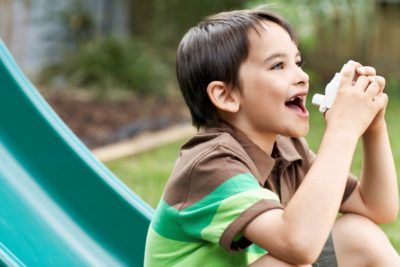Asthma Research is getting a boost. Specifically, new hope is on the horizon if you are a child in an urban setting and you are suffering from asthma.
The National Institute of Allergy and Infectious Diseases (NIAID) is part of the National Institutes of Health. It has gained a great deal of attention with its work during the COVID-19 epidemic. However, this organization has not neglected other pulmonary diseases in the tumult of 2020 and 2021.
Asthma Research Brings New Hope for City Kids with Asthma

The New Network “CAUSE” Will Focus on Treatment and Prevention of Asthma in the Urban Environment.
FLASS is especially proud to blog a few words about the NIAID’s recent establishment of a new clinical research network dedicated to childhood asthma. Recently the NIA mandated ten million dollars in first-year funds for the new network a new network named Childhood Asthma in Urban Settings (CAUSE).
- As a group, the network will commit to both clinical trials and observational studies. And they are dedicated to a better understanding of asthma in children.
- They will also create and develop treatment and prevention approaches tailored to children of low-income families living in urban communities.
The establishment funding of 10 million dollars for the first year is only the beginning. NIAID will be providing approximately $70 million during “the next seven years to support the CAUSE network.”
A New Initiative Based on an Old History of Asthma Research
CAUSE itself is a new establishment. However, NIAID has long attempted to solve the mysteries of the “disproportionate burden of asthma among children living in low-income urban environments.” Asthma research is not new on the NIAID’s agenda. It is a re-commitment to a historic pledge.
- Thus, this new initiative for CAUSE extends and expands NIAID’s long-standing efforts to bring asthma relief to city kids.
- Since 1991 the NIAID has been striving to better understand asthma among city kids.
- We have seen NIAID has sponsored a series of “research programs conducted in urban areas where pediatric asthma is prevalent and severe.”
Ew. A Creepy Example of City Kid’s Asthma Triggers

Childhood Asthma is Often an Underestimated Threat, Especially in Depressed Urban Areas.
For example, it was NIAID-funded research that discovered what FLASS calls the “Cockroach Link.” This classic study proved a vicious cycle between exposure to cockroach allergen and asthma attacks.
Their research took the knowledge of cockroach allergen exposure one step further. They validated it as “a major risk factor for severe asthma in urban children…” Then they discovered programs to decrease exposures to cockroaches and other household allergens. They found that reducing the triggers, like cockroaches, also reduced children’s asthma symptoms. The children not only endured fewer attacks but also racked up fewer doctor’s visits. The “Cockroach Link” was obvious.
Empowering Valid Coast to Coast Studies, Shining Light on Asthma Research
To put it simply, CAUSE investigators will work together to improve understanding of the mechanisms behind asthma development and severity. Their asthma research projects will help will empower health care teams like the doctors and healthcare providers at FLASS.
They will help us to help you. Their cause will be to “develop new strategies to mitigate the impact of the disease in populations of disadvantaged children and adolescents.” It is a CAUSE with real heart at its center—pun well-intended.
Likewise, CAUSE clinical research centers will be located across the United States. They will individually conduct locally relevant clinical and translational studies.
A Few FLASS Fast Asthma Facts from Recent Research
Did you know “Asthma is the most reported chronic condition of childhood in developed countries? And are you aware that 6.5 million children thus affected are living in the USA?
- There is a disparate burden of childhood asthma among socioeconomically disadvantaged youth.
- Asthma patient numbers are often “concentrated in urban areas with high poverty rates.”
- Asthma is not all about Nature vs. Nurture. But both factors count.
On the one hand, do you know the factors that predispose a child to asthma? Asthma Research experts tell us these factors include atopy, male gender, and parental history of asthma… Studies have also proven that there are “race, ethnicity, and genetic and epigenetic susceptibilities.”
Asthma Research is Likewise Focused on Environmental Factors

The Urban Environment Can Feature Many Triggers For Children’s Asthma.
On the other hand, “factors such as improved hygiene, ambient air pollution, and exposures to microbes and aeroallergens,” also influence the development of asthma treatment and prevention.
Terrific Take-Aways from the New Boost for Asthma Research in Childhood Asthma
Circumstances force urban families to spend a great deal of time indoors. Asthma research is proving that “home exposures (such as cockroach, rodent, and indoor air pollution) are highly relevant for urban asthma.” In the face of this challenge, the new CAUSE has been born.
- CAUSE researchers will champion “focused public health initiatives for environmental intervention in high priority risk groups.”
- The CAUSE network comprises a leadership center at the University of Wisconsin-Madison. They are led by principal investigators Daniel Jackson, M.D., and James Gern, M.D., and the following seven clinical research centers:
- Boston Children’s Hospital. Principal investigators: Wanda Phipatanakul, M.D., and Talal Chatila, M.D.
2. Children’s National Research Institute, Washington, D.C. Principal investigator: Stephen Teach, M.D.
3. Cincinnati Children’s Hospital Medical Center. Principal investigator: Gurjit Khurana Hershey, M.D., Ph.D.
4. Columbia University Health Sciences, New York. Principal investigator: Meyer Kattan, M.D.
5. Icahn School of Medicine at Mount Sinai, New York. Principal investigators: Paula Busse, M.D.; Supinda Bunyavanich, M.D.; and Juan Wisnivesky, M.D.
6. Lurie Children’s Hospital of Chicago. Principal investigators: Rajesh Kumar, M.D., and Jacqueline Pongracic, M.D.
7. The University of Colorado Denver. Principal investigator: Andrew Liu, M.D.
Alkis Togias, M.D., and Patrice Becker, M.D., in the Allergy, Asthma and Airway Branch of NIAID’s Division of Allergy, Immunology, and Transplantation, are available to comment on the CAUSE network.
What Else Has Occupied Our Childhood Asthma Research Friends at The National Institute of Allergy and Infectious Diseases (NIAID)?

CAUSE Cannot Cure Asthma. But, We Can Improve the Environment to Reduce the Triggers.
As we stated, childhood asthma research has been a focus in NIAID for quite a while and delivered some amazing discoveries. In case you have not heard, asthma researchers at NIAID also recently established that “omalizumab is a drug that reduces immunoglobulin E. Additionally, it can prevent seasonal asthma attacks.”
Likewise, asthma research scientists have “identified the molecular pathways that evolve in the nasal passages of children with asthma who had colds that led to asthma attacks.”
Watch for both topics in future asthma research blogs from FLASS. And, as always, we thank you for reading.

